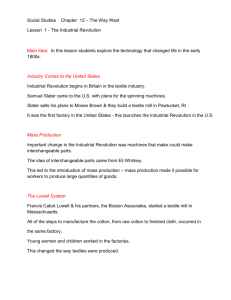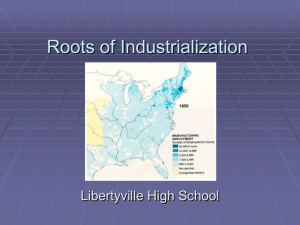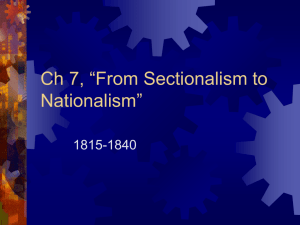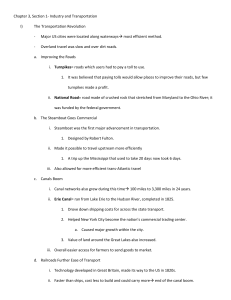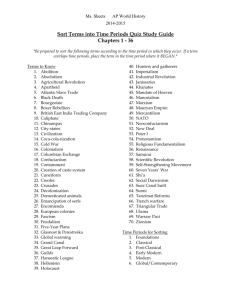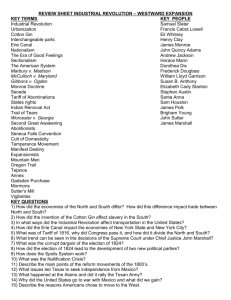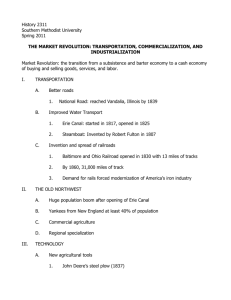New Ideas and Inventions
advertisement
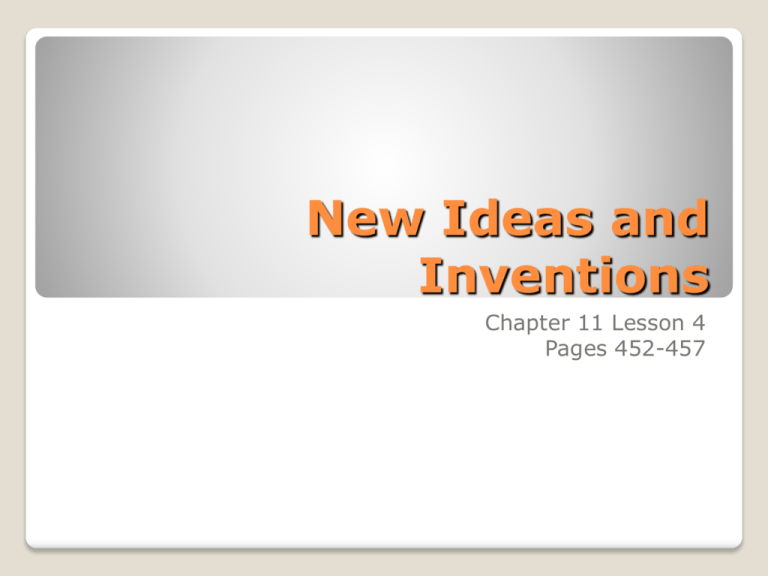
New Ideas and Inventions Chapter 11 Lesson 4 Pages 452-457 What are some GREAT inventions you can think of. How have they made an impact on society? Brainstorm Explain how canals, steamboats, and railroads improved transportation and shipping Describe how new inventions led to the Industrial Revolution Objectives What were forms of transportation used? How did this affect the lives of people? 1700’s TRANSPORTAT ION Early 1800’s Appalachians – difficult to transport goods to the east. Congress votes to build a National Road 1818 – Connects Maryland to West Virginia Slow & Expensive Problem: Rivers had changes in elevation along with rapids and waterfalls making boat travel impossible in some locations BOATS – Cheaper & Faster than by Land CANALS – a human-made waterway that connects bodies of waters. 1817 – NY Governor, DeWitt Clinton, begins work on the Erie Canal (Lake Erie to Hudson River) Solution. . . The Erie Canal 8 years to build 363 miles long 83 locks Connected: Great Lakes to the Atlantic Ocean Cut shipping time & cost Example: Goods from Buffalo to NYC cut from 20 days to 8 days Cost: $100 to $10 LOCK SYSTEM Holds a section of water by two gates. One gate is opened, the water raises or lowers the boat to the next level of water. This is how the boats traveled through different elevation levels. Canal boats are pulled by mules. Here the boat is inside the lock and will be lowering down due to elevation change. Pictures of Miami – Erie Canal The canal boat continues to lower due to the water level changing by opening a lock gate. How did the Erie Canal change trade in the nation? It cut travel time and cost to transport goods. What is a canal? A human-made waterway that connects bodies of water. Steamboats Railroads 1807 Robert Fulton Used the Steam engine to power his boat Clermont Steamboats quickly become primary mode of travel on large rivers. STEAM ENGINE 1830 Peter Cooper Built 1st American locomotive – Tom Thumb Steam is used to power the locomotive over iron rails. Grew rapidly – cheaper than steamboat travel 1850 – over 9,000 miles of track Steam Engines Creates energy by heating liquid water into steam, which is trapped, creating pressure. Releasing the trapped steam causes pistons to move up and down. These are connected to rods, which are connected to wheels that turn as the pistons move. 1800’S New inventions & travel changed thinking Machines are used to do work only done by hand until now Goods made quickly and cheaper This change in manufacturing became known as The Industrial Revolution. INDUSTRIAL REVOLUTION Industrial Revolution started in Britain Machines that spun thread into cloth Placed in factories – Called MILLS Water powered the machines Wanted it kept secret. Machines & the workers were never allowed to leave Britain. Britain Samuel Slater, mill worker Memorized every detail of the machine and mill Sneaked aboard a ship to U.S. 1793 – Slater along with Moses Brown built 1st American textile mill in Pawtucket, RI A spy within. . . Change in U.S. Slater & Brown’s Mill marks the start of large scale manufacturing in the United States. People stop working at home and start working in factories. Most workers are women and children. 1814 – Francis Cabot Lowell Mill in Waltham, Mass. Did all jobs to make raw cotton into finished cloth. Workers lived in nearby houses owned by the mill. Most factories in the North Men, Women, and Children worked Lowell mill paid only $12 a month But better than poor farm work European immigrants arrived and settled near factories South remained agricultural Factory effects . . . COTTON GIN 1793 Eli Whitney Removes seeds from cotton (until now done by hand) Effect: more enslaved workers needed Interchange able Parts Eli Whitney Parts that are made exactly alike Used interchangeable parts for guns Until now, made one at a time by a skilled worker Effect: Now could be mass produced. Mechanical Reaper 1832 Cyrus McCormick Used to harvest grain Steel Plow 1837 John Deere Steel plow allowed farmers to cut through heavy soil in Midwest. Telegraph 1837 Samuel F.B. Morse Sent messages along a wire using a dot and dash code system This becomes known as Morse Code Cause: Because of the Industrial Revolution Effect: Many people moved from farms to cities to work. The U.S. was becoming an industrial power. How did railroads improve life for people in the U.S.? They made it easier to ship goods and for people to travel. What invention led to the increase of slaves on plantations? Cotton Gin Give an example of how a new invention of the Industrial Revolution changed the lives of Americans? Cotton Gin – made it possible to remove the seeds from cotton faster. This results in increased crop production and the need for slaves. Interchangeable Parts – made it easier to mass produce weapons, which reduced their cost for initial production and to replace parts as needed.

